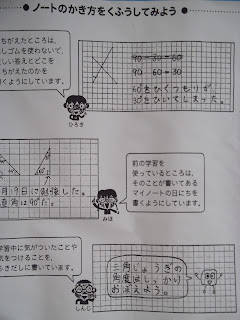During summer reading, I noticed that there are many teachers like me whose students have trouble organizing, especially their own notebooks. It has been a long time wonder, but it has never been addressed with high enough priority in my to-do list. Initially when I started teaching in the U.S., my stereotypical reason was the cultural difference. As I grew up in Japan, my constant mindset was, "My teacher doesn't allow sloppy writing in the notebook. I will be in trouble if I have poor penmanship. She likes my neat writing." The teacher's expectations and criticism were almost a fear in my mind while I looked forward to an occasional praise about my notebook organization. As a teacher, notebook organization didn't seem a big problem in my third grade class. Some sloppy writing was corrected fairly easily with little support. Teaching in the U.S. was a different story. I rolled my eyes when I witnessed students' notebooks that didn't look efficient at all. However, I felt a lot of pressure that I had to say "Good Job!" as long as a correct answer or a main idea was scribed in however the way they described it in the notebook. Some words appeared in the middle of a clear notebook like a spaghetti stain on a brand new white shirt. Some were squeezed into the corner of a page needing a magnifying glass. Although I clearly remember that I had to do something about this crisis back then, what I did was just compromise my expectations. I haven't done anything about it over a decade. What a shame! Now I should focus on it.
Obvious skills that are missed;
- Handwriting itself. Too many letter formations don't look right. Holding a pencil is the difficult task for some students.
- Writing letters on the line. Most students ignore the lines so all of the important recording results are scattered in the notebook.
- Move to the next page. Skipping pages creates terrible disorganization. I don't know why but it is so common among students.

The picture on the right is a Japanese 3rd grade student's math notebook pages. What do you notice? The handwriting...Not perfect, but Yes, it's OK. Written on the lines....Yes. Every line is also aligned on the left. Both pages full...Yes. Other students' notebooks are similarly well organized in this classroom. The graph paged notebook help students write neatly and stay on the line. Since one page is one large rectangle, students know when to start and when to end. Hmmmm... Perhaps it is one of the solutions to organize American students' notebooks.
In this same notebook, there are more important organization tips which help deepen the student's thinking process and understanding the concept. First, this student uses three different colored pencils to clarify what kind of information she is taking. A regular pencil is used for most of the information. She uses a RED pencil for key words in the middle of sentences so it stands out when she comes back to the page in the future. She uses a RED for underlines, too. On the middle left, a sentence is rectangled with straight lines (evidently used a ruler) around with a BLUE pencil. It shows today's question. Each lesson starts with a particular question and goes on with an inquiry process. It is evident that a RED is the most significant and a BLUE is the next most significant. Both colors are not overused on the entire page so that not only its owner, but anybody can understand what she learned in this lesson. Next, the graphics are inserted for visual comprehension of this math concept. Using arrows, circling a letter, showing equations, and describing in sentences are strategies to enrich this students' learning process and mastering level. Colored pencils are good devices to create a meaningful notebook. In addition, I have to mention that note taking skills have to be taught explicitly.
 |
- Scratch off errors instead of erasing so you can learn how you made mistakes and how you corrected later.
- Keep the date each day when the same concept was continued to be taught. It avoids confusion.
- Using a "Talking Bubble" for something you notice during the lesson.

This poster summarizes how to organize a notebook in one math lesson. Major elements that must be included in the daily notebook are; My idea, My friends' ideas, Summary of a lesson, and Feedback to my learning. Since "Feedback" sounds a little vague for many students, they put specificity in this category such as
In today's lesson,
- I understood ......
- I noticed.......
- I would like to think more about ..........
- From my friend's idea, I though about .......
In addition, the blackboard is a "model" notebook for students. Japanese teachers plan how to take notes on the blackboard (Bansho-Keikaku) which is a big part of their daily lesson plans. The Smart Board conveniently stores the math program aligned with the text book so students can see and manipulate the published format through the laptop computer below the screen. Notice, in the top left corner of the picture, there is an overhead screen. The teacher projects the student's samples during the lesson.
As you can see by now, teachers are implementing note taking strategies by modeling in the particular subject lesson. It must be a daily reinforcement, not one-shot note taking lesson. If you are familiar with "I do, We do, and You do," in which I had never heard in Japan, it is surprisingly in action.
- I Do...The Teacher demonstrates planned notes on the blackboard as the lesson goes. (the Smart Board if available) Colors are intentionally utilized.
- We Do...The Teacher assigns students to copy the major parts of the note from the blackboard during the lesson.
- You Do...The Teacher encourages students to show their thinking in sentences, numbers, and graphic representation.
In summary, we, too, implement the note taking strategies/techniques in our daily classrooms. As a team, teachers collaboratively identify their expectations, develop tools (e.g. posters, specific notebooks, lesson plans) , and explicitly and regularly teach them to accomplish the goals.




